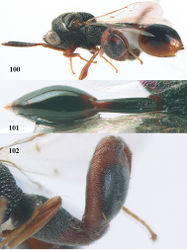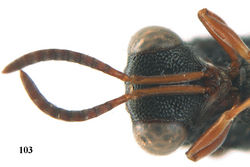Epitranus erythrogaster
| Notice: | This page is derived from the original publication listed below, whose author(s) should always be credited. Further contributors may edit and improve the content of this page and, consequently, need to be credited as well (see page history). Any assessment of factual correctness requires a careful review of the original article as well as of subsequent contributions.
If you are uncertain whether your planned contribution is correct or not, we suggest that you use the associated discussion page instead of editing the page directly. This page should be cited as follows (rationale):
Citation formats to copy and paste
BibTeX: @article{Narendran2016ZooKeys, RIS/ Endnote: TY - JOUR Wikipedia/ Citizendium: <ref name="Narendran2016ZooKeys">{{Citation See also the citation download page at the journal. |
Ordo: Hymenoptera
Familia: Chalcididae
Genus: Epitranus
Name
Epitranus erythrogaster Cameron, 1888 – Wikispecies link – Pensoft Profile
- Epitranus erythrogaster Cameron, 1888: 119 (♀, lectotype selected by Bouček (1982)[1], Japan (Nagasaki) (BMNH) (examined)).
- Anacryptus sculpturatus Crawford, 1910: 129 (♀, lectotype, Philippines (Manila) (USNM) (lectotype selection and synonymized with Epitranus erythrogaster Cameron by Bouček 1982[1])).
- Anacryptus kankauensis Masi, 1933: 12–14 (♀, lectotype, Taiwan (Kankau) (DEI) (lectotype selection and synonymized with Epitranus erythrogaster Cameron by Bouček 1982[1])).
- Arretoceroides ceylonensis Mani, 1936: 128–129 (♂, holotype, Sri Lanka (Peradeniya) (lost?) (synonymized with Epitranus erythrogaster Cameron by Bouček (1982)[1] by implication)).
- Anacryptus raoi Mani & Kurian, 1953: 4–5 (“♂”, holotype, India (Uttar Pradesh, Agra) (lost?) (synonymized with Epitranus erythrogaster Cameron by Bouček (1982)[1] by implication)).
- Chalcitelloides devadatta W. Fernando, 1957: 212–213 (syntypes, Sri Lanka (Kalawewa) (lost?) (synonymized with Epitranus erythrogaster Cameron by Bouček (1982)[1] by implication)).
- Chalcitelloides ajatasattu W. Fernando. 1957[2]: 241–242 (syntypes, Sri Lanka (Talawakele) (lost?) (synonymized with Epitranus erythrogaster Cameron by Bouček (1982)[1] by implication)).
- Pararretoceroides austini W. Fernando, 1957: 241–242 (syntypes, Sri Lanka (Talawakele) (lost?) (synonymized with Epitranus erythrogaster Cameron by Bouček (1982)[1] by implication)).
- Arretcera ambadevia Mani & Dubey (in Mani, Dubey, Kaul & Saraswat), 1973: 13–16 (♂, holotype, India (Borivile National Park nr. Mubai, Thana Hill (USNM) (synonymized with Epitranus erythrogaster Cameron by Bouček (1982)[1]).
- Arretocera nilamburense Mani & Dubey (in Mani, Dubey, Kaul & Saraswat), 1973: 16–17 (♀, holotype, India (Kerala, Nilambur) (USNM) (synonymized with Epitranus erythrogaster Cameron by Bouček (1982)[1]).
- Arretocera pallava Mani & Dubey (in Mani, Dubey, Kaul & Sarawat), 1973: 19–21 (♂, holotype, India (Tamil Nadu) (USNM) (synonymized with Epitranus erythrogaster Cameron by Bouček (1982)[1]).
- Arretocera tanjorensis Mani & Dubey (in Mani, Dubey, Kaul & Saraswat), 1973: 25–28 (♀, holotype, India (Andhra Pradesh) (USNM) (synonymized with Epitranus erythrogaster Cameron by Bouček (1982)[1]).
- Chalcitella nilamburensis Mani & Dubey (in Mani, Dubey, Kaul & Saraswat), 1974: 26–27 (“♂” (= ♀), holotype, India (Nilambur) (USNM) (synonymized with Epitranus erythrogaster Cameron by Bouček (1982)[1]).
- Arretocera malabarensis Mani & Dubey (in Mani, Dubey, Kaul & Saraswat), 1974: 28–29 (“♂” (= ♀), holotype, India (Kerala) (USNM) (synonymized with Epitranus erythrogaster Cameron by Bouček (1982)[1]).
- Epitranus acuminatus Husain & Agarwal, 1982c: 425 (♀, holotype, India (Aligarh) (ZDAMU) (examined) (synonymized with Epitranus erythrogaster Cameron by Narendran (1989)[3]).
Material
3 ♀ (RMNH, IEBR), “S. Vietnam: Dóng Nai, Cát Tiên N. P., Ficus trail, c. 100 m, 1–9.x.2005, Mal[aise] traps 1–8, C. v. Achterberg & R. de Vries, RMNH’05”; 2 ♂ (RMNH, IEBR), id., but 10–29.iv.2007; 1 ♀ (RMNH), id., but 9–26.iv.2007, Crocodile trail; 1 ♂ (RMNH), “C. Vietnam: Ha Tinh, Vu Quang N. P., 111 m, 18°19'40"N 105°26'29"E, 23.ix.–5.x.2009, Mal[aise] trap 23, R. de Vries, RMNH’09”; 4 ♀ (RMNH, IEBR), “S. Vietnam: Dak Lak, Chu Yang Sin N. P., n[ea]r dam, 500 m, Mal[aise] traps, 3–9.vi.2007, C. v. Achterberg & R. de Vries, RMNH’07”; 1 ♀ (RMNH), “N. Vietnam: Ninh Binh, Cuc Phuong N. P., n[ea]r entrance, c. 225 m, 1–15.v.2000, Malaise trap 2, Mai Phu Quy, RMNH’00”; 1 ♀ (IEBR), id., but near centre, 1.xi.–20.xii.2000; 3 ♂ (RMNH, IEBR) “S. Vietnam: Ninh Thuân, Núi Chúa N. P., northeast part, 90–150 m, 23–30.v.2007, Mal[aise] traps, C. v. Achterberg & R. de Vries, RMNH’07”; 151 ♀ + 120 ♂ (DZCU), “India, Kerala, T.C. Narendran & Party, 1984–1989”; 2 ♀ (DZCU), “India, Kerala, Calicut University Campus, 1979, Bouček & Narendran”.
Diagnosis
This species comes near Epitranus crassicornis Bouček in the key to species by Bouček (1982)[1] and Narendran (1989)[3], but differs from it in having: 1) malar space setose (malar space with very few setae in Epitranus crassicornis); 2) antenna not unusually short (in Epitranus crassicornis antenna unusually short and stout, pedicel and flagellum combined only 1.1 × width of head), and 3) mesosoma usually black (in Epitranus crassicornis mesosoma red).
Description
♀♂, length of body 2.4–4.9 mm.
Colour. Body mostly black with reddish colour on legs beyond coxae and at least ventrally on metasoma.
Head. Scrobal area flat with cross striae merging with reticulations; antenna extremely variable in length. In ♀ combined length of pedicel and flagellum 1.0–1.2 × as long as wide; T7 1.3 × as long as broad, scape in ♀ 0.8–1.2 × as long as width of vertex, usually reaching lower margin of anterior ocellus but sometimes shorter. In ♂ flagellum 1.3–2.6 × breadth of head; F1 2.0–3.4 × as long as broad and 0.4–0.8 × length of scape.
Mesosoma. Punctures on pronotum and mesoscutum close, with interstices narrower than diameter of a puncture, mostly smooth, occasionally rugulose; punctures on scutellum deeper than punctures of mesoscutum, interstices smooth and shiny.
Wings. Fore wing 2.8–3.0 × as long as broad, pilosity fairly extensive including a distinct line of setae from the end of fore wing venation to the base of wing and a hair line ventrally of costal cell.
Legs. Hind coxa twice as long as wide, outer ventral margin with 7–12 teeth; hind tibia with subbasal hump often indistinct or indicated by suberect setae and concealed small denticles; tarsal sulcus usually confined to one-third above basal insertion.
Metasoma. Petiole in ♀ 3.8–5.6 x, in ♂ 4.6–6.8 × as long as broad. Petiole shorter than metasoma in both sexes, 0.6–0.7 × length of metasoma.
Variation
Bouček (1982)[1] stated that “extreme forms are connected by numerous transitional forms”.
Host
Corcyra cephalonica Stainton (Lepidoptera: Pyralidae) in rice storage in Kerala (India).
Distribution
India, Nepal, Sri Lanka, Vietnam (Dai Lanh, Bian; Bam Me Thuot; Dalat), Thailand, Laos, Malaysia, Indonesia, Philippines, China (Taiwan), Japan (Bouček 1982[1]; Narendran 1989[3]).
Taxon Treatment
- Narendran, T; van Achterberg, C; 2016: Revision of the family Chalcididae (Hymenoptera, Chalcidoidea) from Vietnam, with the description of 13 new species ZooKeys, (576): 1-202. doi
Images
|
Other References
- ↑ 1.00 1.01 1.02 1.03 1.04 1.05 1.06 1.07 1.08 1.09 1.10 1.11 1.12 1.13 1.14 1.15 1.16 Bouček Z (1982) Oriental chalcid wasps of the genus Epitranus. Journal of Natural History 16: 577–622. doi: 10.1080/00222938200770451
- ↑ Fernando W (1957) Contributions to a knowledge of the insects of Ceylon 5. New parasitic Hymenoptera (Chalcidoidea). Ceylon Journal of Science (B) 25(3): 209–219.
- ↑ 3.0 3.1 3.2 Narendran T (1989) Oriental Chalcididae (Hymenoptera: Chalcidoidea). Zoological Monograph. Department of Zoology, University of Calicut, Kerala, 1–441.

